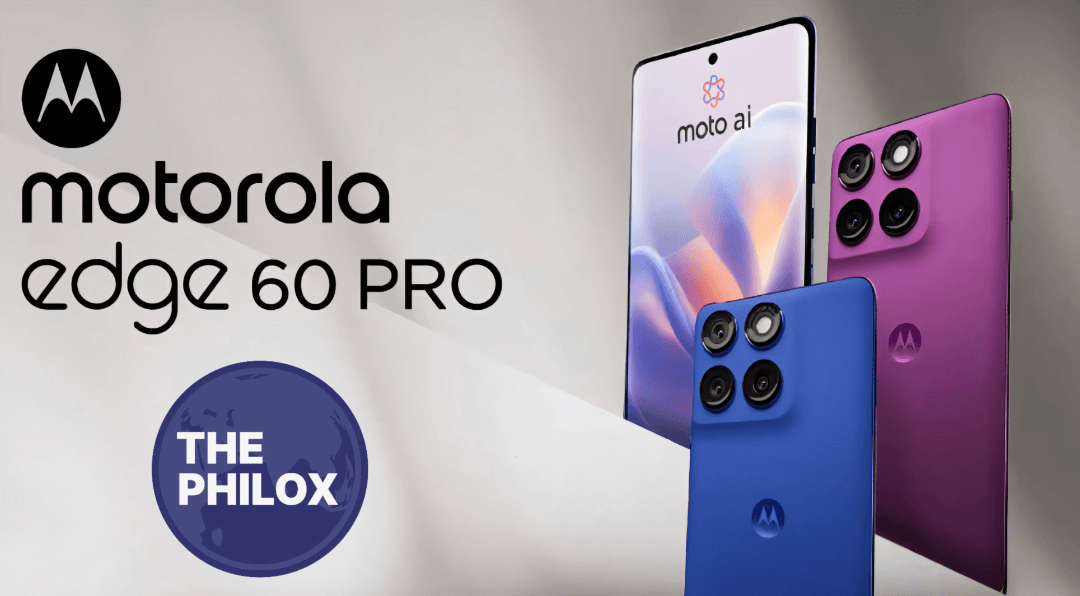

Particularly in the mid-range segment where manufacturers are now stretching the envelope in terms of performance, design, and innovation, the smartphone market has changed fast.
Two quite active brands are Motorola and Nothing. Although Motorola has been committed on providing value and dependability, Nothing has created buzz with its unique design language and simple philosophy.
The newest face-off between Motorola’s Edge 60 Pro and Nothing’s Phone 3a Pro highlights this discrepancy sharply.
Although on paper both phones seem to be equally matched, a closer study shows Motorola has one-up Nothing in important practical areas including battery longevity and robustness.
Motorola’s Endurance Advantage: Battery Performance
Battery life is among the most important parts of any smartphone for its user. The 5000mAh battery of the Motorola Edge 60 Pro supports rapid charging up to 125W, so allowing a full day’s usage in just few minutes of charging.
Users who depend mostly on their phones for productivity or who are always on the go will particularly benefit from this.
On the other hand, the 4500mAh battery of the Nothing Phone 3a Pro boasts 45W quick charging. Although that is commendable, Motorola offers more than that.
Along with a bigger battery, the 60 Pro maximizes power consumption with smart hardware and software integration—including a Snapdragon 8-series processor and Motorola’s clean Android experience with little bloatware.
Motorola also offers battery life management options meant to extend the lifetime of the gadget. This demonstrates the company’s dedication to long-term dependability, something sometimes disregarded in favor of ostentatious design.
Create IP69 Durability and Build Quality: a New Standard
Still another aspect where the Motorola Edge 60 Pro leads significantly is durability. It has an IP69 rating and resists dust, high-pressure water jets, even brief immersion.
This qualifies it as among the toughest cellphones in their class. Rarely found in consumer cellphones, the IP69 classification places Motorola in a privileged group of gadget makers who give physical durability top importance.
Conversely, the IP54 classification of the Nothing Phone 3a Pro provides just rudimentary defense against dust and water splashes.
This might be enough for light, daily use, but in demanding surroundings it does not inspire the same degree of trust.
For its chassis and screen, Motorola also used sturdy materials including Gorilla Glass Victus protection, which increases impact and scratch resistance.
This makes the Edge 60 Pro the ideal friend for outdoor pursuits or for those leading active lives.
Show and Multimedia Experience
OLED high refresh rate displays abound in both the Motorola Edge 60 Pro and the Nothing Phone 3a Pro.
With a 6.7-inch pOLED curved display with HDR10+ capability and 144Hz refresh rate, the Edge 60 Pro Gaming, streaming, and productivity all benefit from the fluid, vivid, highly immersive visual experience.

Nothing Phone 3a Pro has a flat AMOLED panel measuring 6.6 inches with a 120Hz refresh rate.
Although it supports HDR video as well, the somewhat lower refresh rate and brightness peak (as compared to the Edge 60 Pro) might not provide the same degree of visual refinement.
Furthermore, the Motorola’s curved screen not only looks excellent but also helps with ergonomics.
Although both devices have Dolby Atmos capability and stereo speakers, Motorola stands out somewhat with more tuned audio output and stronger bass resonance, therefore providing consumers with an interesting multimedia experience.
Software and Performance: A Tight Battle
Regarding raw performance, on paper both cellphones are exactly matched. Comprising up to 12GB RAM and 256GB UFS 4.0 storage, the Qualcomm Snapdragon 8 Gen 2 CPU drives the Motorola Edge 60 Pro.
Fast app loading, seamless multitasking, and high-end gaming free from stutter guarantees this formidable combo.
Meanwhile, the Nothing Phone 3a Pro runs a Snapdragon 7+ Gen 3 chip, which although competent and capable does not equal the top-tier performance of the Snapdragon 8 Gen 2.
Users of demanding activities as gaming, video rendering, or continuous multitasking may find minute performance variations.
Regarding software, Motorola presents a nearly-stock Android 14 experience with some clever improvements like Moto Gestures and Peek Display. These improvements increase utility without distorting the UI.
Nothing OS 2.5 runs on Nothing’s Phone 3a Pro, likewise based on Android 14. Although the UI is aesthetically different and basic, somewhat less optimal hardware could cause it to be less smooth or responsive under heavy demand.
Features vs. Function: Camera Possibilities
With the Edge 60 Pro, Motorola has advanced the camera field significantly. Its triple camera configuration calls for a 50MP main sensor with OIS, a 13MP ultra-wide camera, and a 2MP macro sensor.
AI advances help the camera system to produce accurate color reproduction, sharp detail, and better low-light performance.
The three-a-pro Nothing Phone features a 50MP ultra-wide lens and a 50MP primary sensor in a dual-camera configuration It enables 4K recording but lacks the sophisticated computational photography capabilities of the Edge 60 Pro.
It performs adequately under reasonable lighting. Particularly in challenging lighting conditions, night mode and dynamic range are also quite less than others.
Motorola’s depth-mapping features help its 32MP front camera to produce clear, natural-looking shots with good backdrop separation for selfies.
Nothing provides a 16MP front camera, which performs satisfactorially but lacks the same degree of sharpness or detail.
Additional Characteristics and Connectivity
Among Motorola’s extensive range of connectivity choices are 5G, Wi-Fi 6E, Bluetooth 5.3, and NFC. It also supports Motorola’s desktop-like interface, which lets users link their phone to PC or external monitor for productivity.
Though it lacks Wi-Fi 6E and any kind of desktop extension capability, Nothing Phone 3a Pro offers 5G, Bluetooth 5.2, and NFC.
Although it maintains universal connection, Motorola’s product more suits professionals seeking increased utility and power users.
Motorola Edge 60 Pro Wins Where Most Counts

Although both cellphones are good candidates in the premium mid-range category, the Motorola Edge 60 Pro obviously provides greater value where it really counts.
It meets practical needs of real-world consumers with a bigger battery, faster charging, more durable build with IP69 certification, and a strong chipset.
Its status as a top-tier pick is strengthened even more by its excellent display, strong camera configuration, and careful software improvements.
Although its original appearance and simple UI make Nothing’s Phone 3a Pro stand-out, its performance, battery life, and durability let down.
The Motorola Edge 60 Pro distinguishes itself as the smarter and more future-ready purchase for consumers who value endurance, dependability, and ruggedness together with flagship-grade performance.







